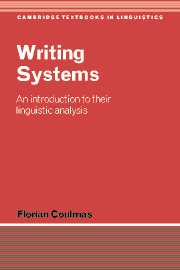Book contents
- Frontmatter
- Contents
- List of illustrations
- List of tables
- Acknowledgements
- A note on fonts
- List of abbreviations and conventions
- 1 What is writing?
- 2 The basic options: meaning and sound
- 3 Signs of words
- 4 Signs of syllables
- 5 Signs of segments
- 6 Consonants and vowels
- 7 Vowel incorporation
- 8 Analysis and interpretation
- 9 Mixed systems
- 10 History of writing
- 11 Psycholinguistics of writing
- 12 Sociolinguistics of writing
- Appendix: Universal Declaration of Human Rights, article 1
- Bibliography
- Index of names
- Index of subjects
2 - The basic options: meaning and sound
Published online by Cambridge University Press: 05 June 2012
- Frontmatter
- Contents
- List of illustrations
- List of tables
- Acknowledgements
- A note on fonts
- List of abbreviations and conventions
- 1 What is writing?
- 2 The basic options: meaning and sound
- 3 Signs of words
- 4 Signs of syllables
- 5 Signs of segments
- 6 Consonants and vowels
- 7 Vowel incorporation
- 8 Analysis and interpretation
- 9 Mixed systems
- 10 History of writing
- 11 Psycholinguistics of writing
- 12 Sociolinguistics of writing
- Appendix: Universal Declaration of Human Rights, article 1
- Bibliography
- Index of names
- Index of subjects
Summary
I remember telling you about a plan for an extraordinary character which would be a means of painting not speech but thoughts like algebraic facts in mathematics. Putting one's discourse into this character one would make calculations and proofs rationally. I believe we could find a method to combine this with the ancient characters of the Chinese.
Gottfried Wilhelm Leibniz 1701The language of this country is different from that of China, so that it is impossible (for us Koreans) to communicate by means of Chinese characters. […] If there are sounds natural to Heaven and Earth, there should certainly be writing natural to Heaven and Earth. Thus ancient people made letters according to the sounds and through them the feeling of the myriad things were communicated.
King Sejong of Korea 1443The diversity of the world's writing systems is enormous, but they can all be interpreted semantically and phonetically. The communication of meaning is the primary purpose of most writing, and in one way or another conventional relationships between graphic and phonic units are established to accomplish this. Meaning and sound are the two referential dimensions utilized by all writing systems. It has sometimes been assumed that writing could work by relying on one of them only. However, a graphic system that expresses meaning directly is as unrealistic as pure transcription, or ‘visible speech’.
- Type
- Chapter
- Information
- Writing SystemsAn Introduction to Their Linguistic Analysis, pp. 18 - 37Publisher: Cambridge University PressPrint publication year: 2002



